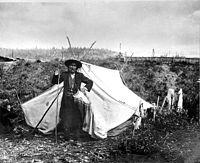Hán

Chief Isaac of the Han, Yukon Territory, ca. 1898
|
|
| Total population | |
|---|---|
| 310 | |
| Regions with significant populations | |
|
|
250 |
|
|
60 |
| Languages | |
| English, Hän | |
| Religion | |
| Christianity | |
| Related ethnic groups | |
| Gwich'in and other Alaskan Athabaskans | |
The Hän (also Hankutchin or Han) are a First Nations people of Canada and an Alaska Native Athabaskan people of the United States; they are part of the Athabaskan-speaking ethnolinguistic group. Their traditional lands centered on a heavily forested area around the Yukon River and straddling what is now the Alaska-Yukon Territory border. In later times, the Han population became centered in Dawson City, Yukon and Eagle, Alaska.
The name Hän is a shortening of Hänkutchin, which is the Gwich’in word hangʷičʼin for the Han, literally meaning "people of the river". This word has been spelled variously as Han-Kootchin, Hun-koo-chin, Hong-Kutchin, An Kutchin, Han Kutchin, Han-Kutchín, Hăn-Kŭtchin´, Hän Hwëch'in, and Hungwitchin. The French traders called the Hän Gens du fou, Gens de Fou, Gens de Foux, Gens des Foux, or Gens-de-fine. The name Gens de Foux (and variants) has also been used to refer to the Northern Tutchone. The Hankutchin were then known as Gens de Bois or Gens des Bois, in association with their forested territory.
The Hän were one of the last Northern Athabascan groups to have contact with European peoples. In 1851 Robert Campbell from the Hudson's Bay Company was the first known white man to enter Han territory, when he traveled from Fort Selkirk to Fort Yukon. It was not until 1873 and 1874 (after the United States purchase of Alaska, that two trading posts were set up. One was established by Moses Mercier, a former employee of the Hudson's Bay Company, in Belle Isle across the Eagle River. The other, Fort Reliance, was established on the Yukon, just below the mouth of the Klondike River, near Dawson, by two Alaska Commercial Company traders, Leroy N. McQuesten and Frank Bonifield. Gradually trading with whites resulted in the Han shifting from their traditional fishing-hunting economy to a fur-trapping economy, as they grew increasingly reliant on such European goods as guns, clothing, and canvas from 1887 to 1895.
...
Wikipedia
